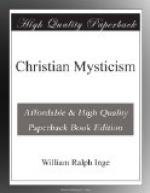Bernard’s homilies on the Song of Solomon gave a great impetus to this mode of symbolism; but even he says that the Church and not the individual is the bride of Christ. There is no doubt that the enforced celibacy and virginity of the monks and nuns led them, consciously or unconsciously, to transfer to the human person of Christ (and to a much slighter extent, to the Virgin Mary) a measure of those feelings which could find no vent in their external lives. We can trace this, in a wholesome and innocuous form, in the visions of Juliana of Norwich. Quotations from Ruysbroek’s Spiritual Nuptials, and from Suso, bearing on the same point, are given in the body of the Lectures. Good specimens of devotional poetry of this type might be selected from Crashaw and Quarles. (A few specimens are included in Palgrave’s Golden Treasury of Sacred Song.) Fenelon’s language on the subject is not quite so pleasing; it breathes more of sentimentality than of reverence. The contemplative, he says, desires “une simple presence de Dieu purement amoureuse,” and speaks to Christ always “comme l’epouse a l’epoux.”
The Sufis or Mohammedan mystics use erotic language very freely, and appear, like true Asiatics, to have attempted to give a sacramental or symbolic character to the indulgence of their passions. From this degradation the mystics of the cloister were happily free; but a morbid element is painfully prominent in the records of many mediaeval saints, whose experiences are classified by Ribet. He enumerates—(1) “Divine touches,” which Scaramelli defines as “real but purely spiritual sensations, by which the soul feels the intimate presence of God, and tastes Him with great delight”; (2) “The wound of love,” of which one of his authorities says, “haec poena tam suavis est quod nulla sit in hac vita delectatio quae magis satisfaciat.” It is to this experience that Cant. ii. 5 refers: “Fulcite me floribus, stipate me malis, quia amore langueo.” Sometimes the wound is not purely spiritual: St. Teresa, as was shown by a post-mortem examination, had undergone a miraculous “transverberation of the heart”: “et pourtant elle survecut pres de vingt ans a cette blessure mortelle”! (3) Catherine of Siena was betrothed to Christ with a ring, which remained always on her fingers, though visible to herself alone. Lastly, in the revelations of St. Gertrude we read: “Feria tertia Paschae dum communicatura desideraret a Domino ut per idem sacramentum vivificum renovare dignaretur in anima eius matrimonium spirituale quod ipsi in spiritu erat desponsata per fidem et religionem, necnon per virginalis pudicitiae integritatem, Dominus blanda serenitate respondit: hoc, inquiens, indubitanter faciam. Sic inclinatus ad eam blandissimo affectu eam ad se stringens osculum praedulce animae eius infixit,” etc.




